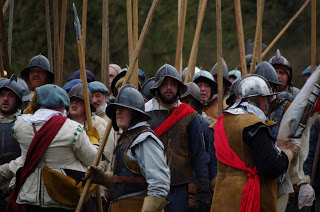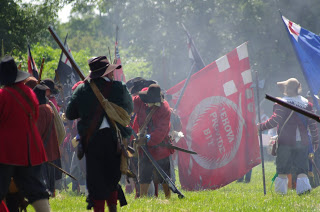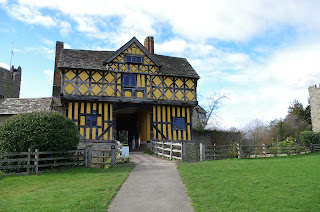Rowton Heath and the Siege of Chester
On the 373rd anniversary of the battle, it's only right and proper to visit, isn't it? Well that's my argument for going, and I'm sticking to it.
 |
| Civil War window, St Chad's |
Charles marched into Chester with 600 soldiers, whilst the remains of the northern horse, under the command of Sir Marmaduke Langdale, were ordered to camp outside the city. Charles believed that he had outwitted his pursuer Poyntz, and had out run him to Chester. Big mistake.
Poyntz met Langdale in the early hours of 24th September. Langdale originally repulsed Poyntz, but Parliamentarian reinforcements from the besieging army arrived and Langdale retreated to Rowton Heath to await his own reinforcements. They were prevented from meeting up with Langdale, and his force was attacked on two fronts. The Royalists suffered considerable losses, including Charles's cousin Lord Bernard Stuart*, and were driven from the field by evening. Charles was reported to watch the destruction of his forces from Phoenix Tower on Chester city walls. Charles left Chester the next day, retreating to Denbigh.
As well as mourning his cousin, Charles was also to mourn his "musician in ordinary for lutes and voices", William Lawes. Lawes composed many notable musical works, and at the outbreak of war joined the King's Life Guard of Horse (which was supposed to keep him out of harms way). Sadly he was "casually shot" during the rout from Rowton; Charles would institute a special mourning for Lawes bestowing upon him the title "Father of Musick".
The battlefield today is no longer open heathland - it is now a mixture of agricultural land and upmarket residences. The battlefield is easily accessed by a number of footpaths, but bears little relation to the seventeenth century landscape.
A recent memorial erected in the centre of Rowton is the only recognition of the battle.
Local legend says that a ruined building by the A41 was used as a field hospital during the battle, but was hidden by vegetation when I visited.
The battlefield today is no longer open heathland - it is now a mixture of agricultural land and upmarket residences. The battlefield is easily accessed by a number of footpaths, but bears little relation to the seventeenth century landscape.
A recent memorial erected in the centre of Rowton is the only recognition of the battle.
Local legend says that a ruined building by the A41 was used as a field hospital during the battle, but was hidden by vegetation when I visited.
Chester had been besieged for most of 1645, and there are many areas of interest on the city walls. There is an app 'Chester Walls Quest' which might encourage your youngling to be slightly more enthusiastic about walking the walls - more information about the app and the walls in General at Explore the Walls. There is a guide to Chester during the Civil War, strangely not available to purchase in Chester itself: you'll have to travel to Nantwich Museum to pick up a copy. (The history section of the booklet is good, but the tour of Chester section misses a number of important places out.)
Starting at the Water Tower corner: Bonewaldesthorne's Tower is the tower on the walls circuit (the adjacent Water Tower is closed off to public access). The tower still bears the marks of musket balls.
Walking in a clockwise direction, you'll see a badly weathered eighteenth century plaque marking the restoration of the Civil War damage to the walls at Goblin Tower.
Next up is Morgan's Mount which was used as a gun platform.
Carry on to Phoenix Tower, or as it is now known King Charles's Tower. Charles is supposed to have watched the defeat of his army at Rowton at this tower, he must have had excellent eyesight and a very long neck as it is impossible to see the Rowton battlefield from here. The Tower is open to the public, but has somewhat erratic opening times.
Update September 2022: I've finally made it inside the tower after years of trying. The tower now only opens during special occasions such as the Cheshire Heritage Festival. Where once there were displays inside, the space is given over to an enormous array of spiders' webs, and a very impressive piece of structural architecture stopping the tower collapsing into the canal.
Starting at the Water Tower corner: Bonewaldesthorne's Tower is the tower on the walls circuit (the adjacent Water Tower is closed off to public access). The tower still bears the marks of musket balls.
Walking in a clockwise direction, you'll see a badly weathered eighteenth century plaque marking the restoration of the Civil War damage to the walls at Goblin Tower.
Next up is Morgan's Mount which was used as a gun platform.
Carry on to Phoenix Tower, or as it is now known King Charles's Tower. Charles is supposed to have watched the defeat of his army at Rowton at this tower, he must have had excellent eyesight and a very long neck as it is impossible to see the Rowton battlefield from here. The Tower is open to the public, but has somewhat erratic opening times.
Update September 2022: I've finally made it inside the tower after years of trying. The tower now only opens during special occasions such as the Cheshire Heritage Festival. Where once there were displays inside, the space is given over to an enormous array of spiders' webs, and a very impressive piece of structural architecture stopping the tower collapsing into the canal.
South of Phoenix Tower you'll find ramps down to the Cathedral and a gate through to the Kaleyard car park.
 |
| The sally port |
This gate is the original sally port, from which raids could slip out of the city. The first planned raid failed at the first hurdle, nobody could find the key to the gate.
Carry on in a clockwise direction to the Roman Gardens. Here you'll see where the breach occured. Small people will enjoy lining up the interpretation panel with the restored walls (purists will shudder at the musketeers wearing morion helmets).
St John the Baptist's church, close to the amphitheatre was Chester's original cathedral and priory. Located in an elevated position outside the city walls, it was ideally placed to be an offensive position for anyone wishing to besiege the city.
St John the Baptist's church, close to the amphitheatre was Chester's original cathedral and priory. Located in an elevated position outside the city walls, it was ideally placed to be an offensive position for anyone wishing to besiege the city.
So it will come as no surprise that it was used as a garrison and gun platform by Parliament's men in 1645. The church suffered extensive damage during the siege, made worse by Victorian builders who were attempting to stabilise the tower.
Inside St John's is an amazing collection of C17th funerary memorials. Charles and the Battle of Rowton Heath are immortalised in the C19th stained glass.
There is also a rare Commonwealth era font.
Staying at ground level, carry on through the gardens towards the river. Here you'll find yourself at the base of Barnaby's Tower which was damaged by Parliamentarian cannon fire. This damage is hard to distinguish from the natural weathering of the stone now.
Close to Eastgate is the now empty Boot Inn. Opened in 1643, the inn was a notoriously bawdy inn and brothel.
Close to Eastgate is the now empty Boot Inn. Opened in 1643, the inn was a notoriously bawdy inn and brothel.
You'll find several references, online, to the Grosvenor Museum exhibiting a number of period military artefacts - sadly these are no longer on display. The big ticket item at the museum is clearly the Romans. Nor does the Heritage Centre have a 'stunning' Civil War display as the Centre doesn't exist anymore.
The Grosvenor Museum does have a small number of Civil War finds on display in their Grosvenor Park excavation display.
Chester Cathedral was used as a look out post during the siege, its tower providing an excellent vantage point. Located on Saint Werburgh's Street, this area saw heavy fighting on the 19th September 1645. There appear to be some pock mark scars (from musket balls) in the stone work around the Cathedral's west door.
Inside the Cathedral there is a memorial to Sir William Mainwairing, who fell in the siege, in the south transept.
The arts and crafts movement celebrated Chester's royal connection, a statue of Charles I adorns the old Sherrat & co art gallery on Bridge Street (number 55).
Outside the walled centre of the city is Rock Lane, or Prince Rupert's Great Trench.
Cut into the bedrock the trench allowed the Royalist defenders to move artillery pieces out of sight of the besieging army.
Due to it's close proximity to the University there are parking restrictions everywhere, parking is available on the main road about a kilometre away close to a kitchen shop (CH1 4AJ).
Finally a gun emplacement called Brewer's Hall Mount. Located on the 7th tee at Chester Golf Club, the location is best approached from the Riverside Promenade walk. Walk to Chester Race Course, and aim for the railway bridge.
A footbridge goes alongside the rail bridge over the river. Be warned - express trains thunder past, and they will rattle your fillings. On the other side of the bridge, the footpath turns right into the golf club's car park. The footpath (a lane) goes to the right.
Follow the lane to the groundskeepers' buildings. Walk past the first building, there are more buildings a little further on, and a yard on your right. Turn left here off the lane towards the golf course. Cross the drainage ditch by the little bridge, and you'll see the marker stone erected by the golf club. Please be respectful of the golfists, and allow them to take their shots before approaching the tee.
The Parliamentarian besiegers installed a gun emplacement here from which to bombard the city. I really struggled to find this, and had to ask one of the groundskeepers for directions: he told me that he had been involved in some of the work improving the 7th tee, during which they found evidence of the emplacement.
Outside the walled centre of the city is Rock Lane, or Prince Rupert's Great Trench.
Cut into the bedrock the trench allowed the Royalist defenders to move artillery pieces out of sight of the besieging army.
Due to it's close proximity to the University there are parking restrictions everywhere, parking is available on the main road about a kilometre away close to a kitchen shop (CH1 4AJ).
Finally a gun emplacement called Brewer's Hall Mount. Located on the 7th tee at Chester Golf Club, the location is best approached from the Riverside Promenade walk. Walk to Chester Race Course, and aim for the railway bridge.
A footbridge goes alongside the rail bridge over the river. Be warned - express trains thunder past, and they will rattle your fillings. On the other side of the bridge, the footpath turns right into the golf club's car park. The footpath (a lane) goes to the right.
Follow the lane to the groundskeepers' buildings. Walk past the first building, there are more buildings a little further on, and a yard on your right. Turn left here off the lane towards the golf course. Cross the drainage ditch by the little bridge, and you'll see the marker stone erected by the golf club. Please be respectful of the golfists, and allow them to take their shots before approaching the tee.
The Parliamentarian besiegers installed a gun emplacement here from which to bombard the city. I really struggled to find this, and had to ask one of the groundskeepers for directions: he told me that he had been involved in some of the work improving the 7th tee, during which they found evidence of the emplacement.
Locally, St Chad's Church in Farndon was used as a Parliamentarian barracks, but is now more famous for the Civil War window, which was commissioned in 1662. Postcard representations of the window available from the church. There was a skirmish at the local bridge when local Parliamentarians crossed over the river into Wales. (The bridge used to boast a tower on the Welsh side - long since gone, but if you visit take a look at the arches of the bridge, the first arch on the Welsh side is much lower and was beefed** up to take the weight of the tower.) Parliament's men built a bridge of boats, which distracted the Royalist guards at the bridge, whilst even more Parliamentarians stormed the tower and take the bridge.
On the other side of the river is the town of Holt. St Chad's Church was used as a garrison by the Royalists. The church saw a small siege and skirmish. Inside one of the walls bears damage (from musket balls) and loopholes were cut into the door (small loopholes, just big enough to poke a musket barrel through, the musketeer would have had no idea who they were firing at).
For more Cheshire related Civil War sites see also:
Dunham Massey * Portrait of Lord Bernard Stuart and his brother can be found in the National Gallery; my photo of the portrait can be found in an earlier post here (Lord Bernard is the one on the right).
** This is a technical architect's term
Selected Bibliography
The Great Siege of Chester J.Barratt, History Press
Postcodes for SatNavs
Selected Bibliography
The Great Siege of Chester J.Barratt, History Press
Postcodes for SatNavs
Rowton Heath memorial CH3 6AD
Grosvenor Museum CH1 2DD
Chester Cathedral CH1 2DY
Church of St John the Baptist, Vicar's Lane CH1 1QX
Rock Lane (Prince Rupert's Trench), Cheyney Road end CH1 4BRSt Chad's Farndon CH3 6RX
Farndon Bridge LL13 9JH
St Chad's Holt LL13 9JP
Holt Castle LL13 9AZ
If you enjoyed reading this, or any of the other posts, please consider supporting the blog.
Thanks.


































.jfif)





Comments
Post a Comment